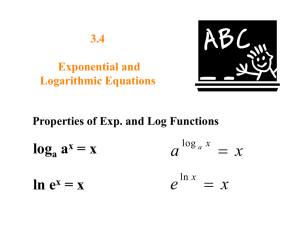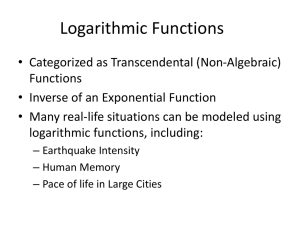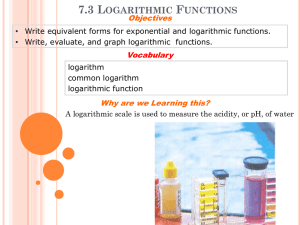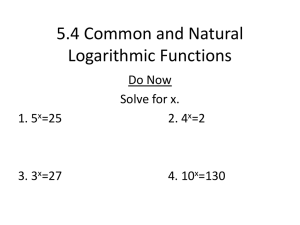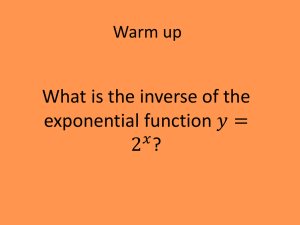Logarithmic function
advertisement
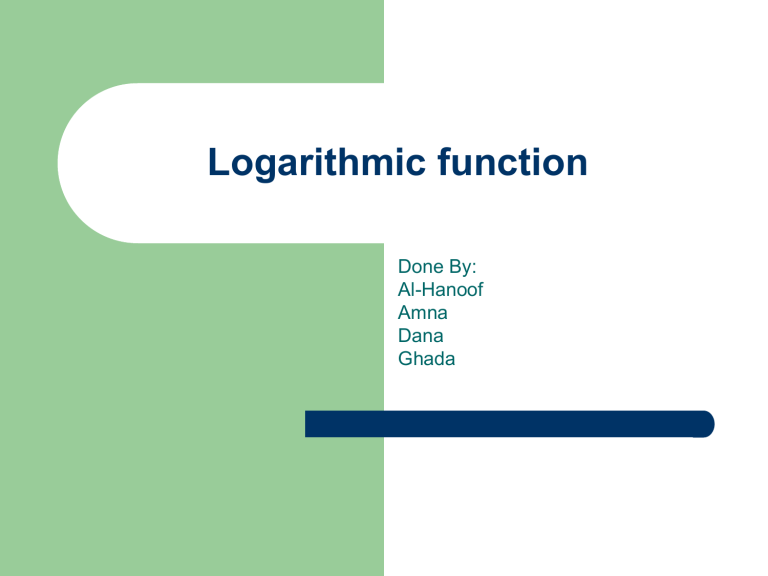
Logarithmic function Done By: Al-Hanoof Amna Dana Ghada Logarithmic Function Changing from Exponential to Logarithmic form. ( Ghada ) Graphing of Logarithmic Function.( Amna ) Common Logarithm.( Ghada ) Natural Logarithm.( Ghada ) Laws of Logarithmic Function. ( Dana ) Change of the base.( Ghada ) Solving of Logarithmic Function.( Al-Hanoof ) Application of Logarithmic Function.(Al-Hanoof) Logarithmic Function Every exponential function f(x) = a x, with a > 0 and a ≠ 1. is a oneto-one function, therefore has an inverse function(f-1). The inverse function is called the Logarithmic function with base a and is denoted by Loga Let a be a positive number with a ≠ 1. The logarithmic function with base a, denoted by loga is defined by: Loga x = y ay=Х Clearly, Loga Х is the exponent to which the base a must be raised to give Х Logarithmic Function Logarithmic form Exponent Loga x = y Base Exponential form Exponent a^ y = Х Base Logarithmic Function Example: Logarithmic form Log2 8= 3 Exponential form 2^3=8 Logarithmic Function Graphs of Logarithmic Functions: The exponential function f(x) =a^x has Domain: IR Range: (0.∞), Since the logarithmic function is the inverse function for the exponential function , it has Domain : (0, ∞) Range: IR. Logarithmic Function The graph of f(x) = Loga x is obtained by reflecting the graph of f(x) = a^ x the line y = x x-intercept of the function y = Loga x is 1 f(x) = a^ x y=x Logarithmic Function y = loga x y 4 3 2 1 x -4 -3 -2 -1 1 2 3 4 -1 -2 -3 -4 This is the basic function y= Loga x Logarithmic Function y =- loga x y 4 3 2 1 x -4 -3 -2 -1 1 2 3 4 -1 -2 -3 -4 The function is reflected in the x-axis. Logarithmic Function y = log2 (-x) y 4 3 2 1 x -4 -3 -2 -1 1 2 3 4 -1 -2 -3 -4 The function is reflected in the y-axis. Logarithmic Function Y=loga(x+2) y 4 3 2 1 x -4 -3 -2 -1 1 2 3 4 -1 -2 -3 -4 The function is shifted to the left by two unites . Logarithmic Function y = loga (x-2) y 4 3 2 1 x -4 -3 -2 -1 1 2 3 4 -1 -2 -3 -4 The function is shifted to the right by two unites . Logarithmic Function y = logax +2 y 4 3 2 1 x -4 -3 -2 -1 1 2 3 4 -1 -2 -3 -4 The function is shifted to the upward by two unites . Logarithmic Function y = loga x -2 y 4 3 2 1 x -4 -3 -2 -1 1 2 3 4 -1 -2 -3 -4 The function is shifted to the downward by two unites . Logarithmic Function Example: Finding the domain of a logarithmic function: F(x)=log(x-2) Solution: As any logarithmic function lnx is defined when x>0, thus, the domain of f(x) is x-2 >0 X>2 So the domain =(2,∞) Logarithmic Function Common Logarithmic; The logarithm with base 10 is called the common logarithm and is denoted by omitting the base: log x = log10x Natural Logarithms: The logarithm with base e is called the natural logarithm and is denoted by In: ln x =logex Logarithmic Function The natural logarithmic function y = In x is the inverse function of the exponential function y = e^X.By the definition of inverse functions we have: ln x =y e^y=x y 4 Y=e^x 3 2 1 x -4 Y=ln x -3 -2 -1 1 -1 -2 -3 -4 2 3 4 Logarithmic Function Laws of logarithms: Let a be a positive number, with a≠1. let A>0, B>0, and C be any real numbers. 1. loga (AB) = loga A + loga B log2 (6x) = log2 6 + log2 x 2. loga (A/B) = loga A - loga B log2 (10/3) = log2 10 – log2 3 3. loga A^c = C loga A log3 √5 = log3 51/2 = 1/2 log3 5 Logarithmic Function Rewrite each expression using logarithm laws log5 (x^3 y^6) = log5 x^3 + log5 y^6 law1 = 3 log5 x + 6 log5 y law3 ln (ab/3√c) = ln (ab) – ln 3√c law2 = ln a + ln b – ln c1/3 law1 = ln a + ln b – 1/3 ln c law3 Logarithmic Function Express as a single logarithm 3 log x + ½ log (x+1) = log x^3 + log (x+1)^1/2 law3 =log x^3(x+1)^1/2 law1 3 ln s + ½ ln t – 4 ln (t2+1) = ln s^3 + ln t^1/2 – ln (t^2+1)^4 law3 = ln ( s^3 t^1/2) – ln (t^2 + 1)^4 law1 = ln s^3 √t /(t2+1)^4 law2 Logarithmic Function *WARNING: loga (x+y) ≠ logax +logay Log 6/log2 ≠ log(6/2) (log2x)3 ≠ 3log2x Logarithmic Function Change of Base: Sometimes we need to change from logarithms in one base to logarithms in another base. b^y = x (exponential form) logab^y = logax y log a b =logax y=(loga x)/(loga b) (take loga for both sides) (law3) (divide by logab) Logarithmic Function Example: Since all calculators are operational for log10 we will change the base to 10 Log8 5 = log10 5/ log10 8≈ 0.77398 (approximating the answer by using the calculator) Logarithmic Function Solving the logarithmic Equations: Example: Find the solution of the equation log 3^(x+2) = log7. SOLUTION: (x + 2) log 3=log7 (bring down the exponent) X+2= log7 (divide by log 3 ) log 3 x = log7 -2 (subtract by 2) log3 Logarithmic Function Application of e and Exponential Functions: In the calculation of interest exponential function is used. In order to make the solution easier we use the logarithmic function. A= P (1+ r/n)^nt A is the money accumulated. P is the principal (beginning) amount r is the annual interest rate n is the number of compounding periods per year t is the number of years There are three formulas: A = p(1+r) Simple interest (for one year) A(t) = p(1+r/n)nt Interest compounded n times per year A(t) = pert Interest compounded continuously Logarithmic Function Example: A sum of $500 is invested at an interest rate 9%per year. Find the time required for the money to double if the interest is compounded according to the following method. a) Semiannual b) continuous Solution: (a) We use the formula for compound interest with P = $5000, A (t) = $10,000 r = 0.09, n = 2, and solve the resulting exponential equation for t. (1.045)^2t = 2 (Divide by 5000) log (1.04521)^2t = log 2 (Take log of each side) 2t log 1.045 = log 2 Law 3 (bring down the exponent) t= (log 2)/ (2 log 1.045) (Divide by 2 log 1.045) t ≈ 7.9 The money will double in 7.9 years. (using a calculator) Logarithmic Function (b) We use the formula for continuously compounded interest with P = $5000, A(t) = $10,000, r = 0.09, and solve the resulting exponential equation for t. 5000e^0.09t = 10,000 e^0.091 = 2 (Divide by 5000) In e0.091 = In 2 0.09t = In 2 t=(In 2)/(0.09) t ≈7.702 The money will double in 7.7 years. (Take 10 of each side) (Property of In) (Divide by 0.09) (Use a calculator)
